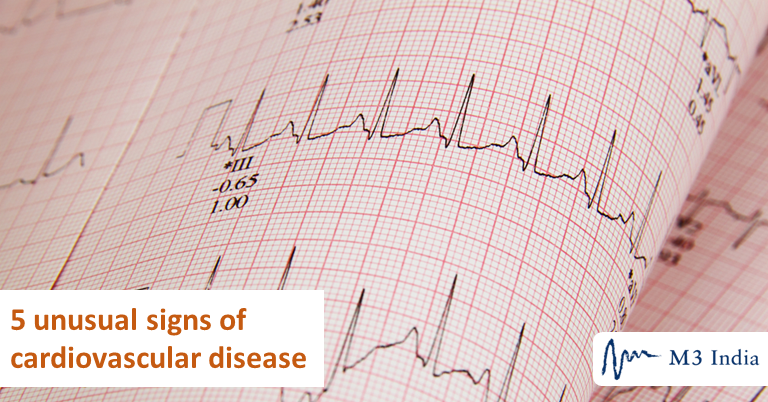5 unusual signs of cardiovascular disease
M3 Global Newsdesk Apr 19, 2019
Summary
The ears, nails, forehead, scalp, and oral cavity could all be unusual parts of the human body to show subtle indications of CVD. Therefore, it may be a good idea to keep an eye out on these areas for certain signs that might indicate heart disease.

Death rates for coronary heart disease in the United States have dropped by two-thirds during the past 40 years due to improved diagnosis, treatment, and interventions for the management of arrhythmias, coronary artery disease, and heart failure.
Cardiovascular disease (CVD), however, still accounts for 35% of all American deaths per year (ie, 1 million deaths), and is clinically diagnosed in 80 million Americans, or about 35% of the US adult population. Although the absolute number of deaths due to CVD has dropped among male patients, it has risen among females.
More common symptoms of CVD can be traced directly back to the heart, such as chest discomfort from ischemia and edema from the heart's reduced ability to pump. Other primary manifestations of heart disease include dyspnea, palpitations, hypotension, and syncope.
However, certain unusual indicators of CVD do present. Thus, it may be a good idea to keep an eye out for the following five signs that might indicate heart disease. Keep in mind that a quarter of all deaths due to heart disease are sudden—so always be on the lookout.
Diagonal earlobe crease
An observable crease stretching at least one-third the distance from the tragus to the posterior pinna has been correlated with a higher frequency of cardiac events in patients with probable coronary heart disease, according to numerous studies. Called Frank's sign, this finding is more common among the elderly and is thought to be due to age-related loss of dermal and vascular elastic fibers. Notably, the link between earlobe creases and CVD is debated by some experts.
Clubbed nails
In people with clubbed nails, the angle between the proximal nail fold and nail plate is greater than 180°. Cyanosis may be present with clubbing. Clubbed nails originate from hypertrophy of soft-tissue components of digital pulp and hyperplasia of fibrovascular tissue at the nail base. Clubbed nails are commonly a sign of aortic aneurysm, congenital CVD, and acquired CVD.
Forehead wrinkles
People who have many deep forehead wrinkles may be at higher risk of dying from CVD, according to research presented at the European Society of Cardiology Congress 2018. These people have many more forehead wrinkles than expected for their age.
The investigators assigned wrinkle scores, based on number and depth of wrinkles, to 3,200 working adults and followed them for 20 years. They found that the higher the wrinkle score, the higher the cardiovascular mortality. They hypothesized that horizontal forehead wrinkles could be related to atherosclerosis and plaque accumulation. Arteries in the forehead are small and susceptible to plaque accumulation, with wrinkles being an early sign of vessel senescence. Moreover, collagen protein changes and oxidative stress both play roles in atherosclerosis and wrinkle development.
Vertex baldness
Vertex baldness, or male-pattern baldness that originates at the crown of the head, has been correlated with an increased risk of CVD. Investigators, however, have not identified any association between CVD and frontal baldness. The strength of this association depends on the degree of vertex baldness, with this association extant among younger men as well.
Poor oral health
Markers of poor oral health, such as tooth loss and gum disease, have been linked to higher CVD risk. This association becomes less clear, however, after accounting for covariates such as smoking. One possible explanation for the link between poor oral health and heart disease could be that bacteria from the mouth travel to arteries in the body, causing blood vessel damage and inflammation, which can contribute to heart disease.
This story is contributed by Naveed Saleh and is a part of our Global Content Initiative, where we feature selected stories from our Global network which we believe would be most useful and informative to our doctor members.
-
Exclusive Write-ups & Webinars by KOLs
-
Daily Quiz by specialty
-
Paid Market Research Surveys
-
Case discussions, News & Journals' summaries